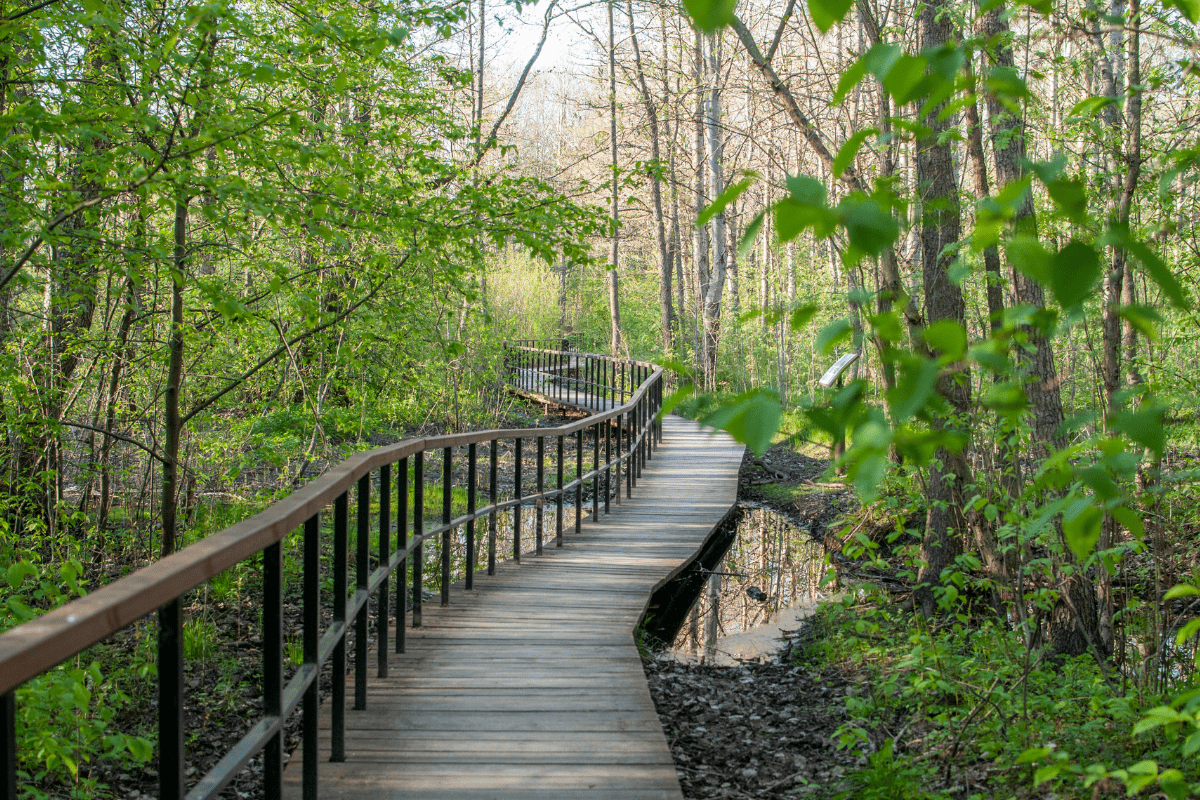Eugene is surrounded by scenic landscapes and lush forests, making it a paradise for anyone who loves to get outside and explore on foot. Whether you prefer a challenging summit climb or a gentle stroll past wildflowers and city views, there’s a trail here to match every mood and skill level.
Let’s get to it.
Rhododendron Garden
Nestled in Eugene’s Hendricks Park, Rhododendron Garden offers a woodland setting beneath Oregon white oaks and Douglas firs. Thousands of rhododendrons bloom in spring alongside witch hazels, magnolias and trilliums.
Packed gravel trails loop across a terraced hillside, providing mild inclines, occasional steps and spots to pause. Walking the loop offers a gentle workout, and on higher terraces you can admire panoramic views of downtown Eugene. The paths are mostly wheelchair accessible, though a few segments are steeper. Benches, picnic tables and drinking fountains are spaced along the routes, inviting you to rest and take in the blooms.
Parking near the F.M. Wilkins Shelter restrooms makes logistics straightforward. Dogs aren’t allowed inside the garden proper but can join you in the picnic and forest areas. This garden draws crowds during April and May, but weekday or off-season visits often mean fewer visitors.
Spencer Butte Park
For hikers seeking a view, Spencer Butte Park delivers a challenging climb and rewarding summit. The main trail loops 1.6 miles through Douglas fir stands and open meadows, gaining about 700 feet of elevation and navigating rocky sections with lengthy stone stairways.
Side routes like the West Slope and Tie Trail add steep stretches, while the full Ridgeline option exceeds five miles and demands strong legs. At the top, benches allow you to soak in 360-degree vistas of Eugene and the Willamette Valley. Spring brings wildflower patches and occasional wildlife sightings. The main path grows busy on weekends, so try the West Slope or Ridgeline segments for more solitude.
Parking is free and trail maintenance is solid, thanks to restored stairs. There are no paved ramps, so this park is not stroller-friendly. Dogs must remain leashed and hikers should wear sturdy shoes. Water fountains and a small parking lot sit at the trailhead for convenience.
Hendricks Park
Spanning almost 80 acres, Hendricks Park blends mature Douglas firs and oaks with winding paths that suit all levels. Trails range from easy strolls to moderate climbs, and the Ribbon Trail gains 383 feet through shaded forest.
Spring wildflowers dot routes like the West Trail and several loops. From April through May, a standout 15-acre rhododendron section bursts with color along gravel and paved paths. Plant labels help you learn varieties, and strollers or wheelchairs navigate the main garden—dogs must stay outside that section, though leashed pets are welcome on woodland trails.
Parking, restrooms and picnic tables are scattered throughout the park. The park’s Douglas firs include specimens over a century old. A reservable shelter near the ridge offers city views beyond the treetops. An information board at the main entrance shares seasonal highlights. Trails may get muddy in winter but dry out by late spring. Weekday or off-season visits usually mean fewer people, and park crews keep the area tidy year-round.
Ridgeline Trail – Fox Hollow Trailhead
Fox Hollow Trailhead near Eugene really lives up to its outdoor reputation. The Ridgeline Trail section offers a mix of options, from a gentle 1.8-mile loop winding through bigleaf maple and Douglas-fir stands, to a challenging climb up Mt Baldy with more than 700 feet of elevation gain. Along the way you’ll pass an oak savanna and a surprise ponderosa pine plantation. In spring, wildflowers like trillium and wild iris add bright spots of color.
The trails alternate between well-groomed gravel and classic Oregon mud on wet days. Boardwalk bridges with handrails keep you dry over marshy sections, and clear trail markers guide each turn. A gravel parking area holds about a dozen cars, though weekends fill up fast. There’s a single port-a-potty (no running water), and dogs are welcome on leash. At peak hours you’ll see quite a parade of people and pets. For a quieter experience, aim for a morning in spring or summer.
Wayne Morse Family Farm
Covering 27 acres, Wayne Morse Family Farm offers a gentle loop trail around woods and open meadows. The wide dirt path requires no steep climbs.
Picnic tables and a large event shelter stand near open restrooms and an old water spigot. A fenced off-leash area draws dogs in full sprint. Elsewhere, pets must remain on leash. Large grass areas invite relaxation and the trailhead features an informational sign describing the farm’s history. No fees or reservations are required. The trail remains firm even after light rains, making it reliable in most weather.
Wild turkeys sometimes wander through the fields, adding local charm. Most visitors include dog owners and casual strollers, and the grounds rarely feel crowded. Park staff maintain the turf and clear the trail, so you won’t find large mud puddles or broken benches. Open daily from sunrise until late evening, the farm welcomes visitors year-round, rain or shine.
Mount Pisgah Arboretum
Offering a variety of Oregon landscapes, Mount Pisgah Arboretum features over eight miles of maintained trails through oak savannas, wetlands and wildflower patches. Boardwalks and bridges keep your feet dry near creeks.
Trail difficulty ranges from easy loops like Improved Access and Barrier-Free to the steeper Summit Trail. Surfaces vary between packed gravel, dirt and mulch. The Summit Trail gains height steadily, while the Upper Plateau and Creek Trails stay mostly level and quieter. An entrance map and seasonal guide near the parking lot help plan your route.
Free parking and restrooms by the White Oak Pavilion start every visit smoothly. Benches dot the trails and dogs are welcome on leash. No horses or bikes are allowed. Winter and early spring can bring muddy conditions, so sturdy shoes are recommended. Wildlife sightings and views of the Cascade foothills reward those who pause. This place runs year-round, rain or shine.
Skinner Butte Lookout
Smack in the middle of Eugene, Skinner Butte Lookout delivers a quick escape without leaving town. Most trails are gently graded for easy walking, though the final ascent ramps up just before the summit. You can choose a full 1.6-mile loop linking Skinner Butte with the South Bank, or stick to a one-mile out-and-back from the north side. Lower sections feature paved or compact gravel surfaces, while the top includes some loose rocks and dirt.
Amenities are surprisingly robust: public restrooms, picnic tables, drinking water, and a small summit parking lot. A playground at the base keeps kids amused on the way up. The route is accessible for wheelchairs and strollers, and leashed dogs are invited too. Sunrises and sunsets draw crowds, especially during fireworks displays when the city lights dazzle below. Benches are scattered along the way for birdwatching or lingering over the view. The City of Eugene maintains clear signage and regularly clears any undergrowth.
Skinner Butte Park
Skinner Butte Park combines easy riverside strolls with steeper climbs up the butte itself. A 1.6-mile loop along the river stays flat and paved—ideal for strollers, wheelchairs, and duck watchers. If you want more of a workout, several side trails wind up the butte on compact dirt and basalt rocks. Expect about a 250-foot gain or 400 feet if you start at the riverbank. Handrails at key viewpoints offer extra security.
From the top, you’ll enjoy sweeping views of the Willamette Valley and Eugene’s skyline. Spring brings a host of migratory birds to the overlook. The park draws rock climbers to the Columns area, while families flock to playgrounds, gardens, and picnic tables. Parking is usually ample at both the base and the summit, except during fire season when the upper lot may close. Dogs on leash enjoy their own water spigots. Restrooms, benches, and fresh drinking water are available throughout the park.
Alton Baker Park
Alton Baker Park offers a surprising variety of paths for runners, walkers, and birdwatchers alike. Pre’s Trail features three woodchip loops—Big, Parcourse, and Bottom—that cushion your joints. The Parcourse Loop has a few uneven spots, but nothing that demands heavy boots. For a longer outing, the 3.4-mile Nature Loop passes wetlands, duck ponds, and open meadows. Interpretive signs and the Kalapuya Talking Stones add local history without the need for headphones.
Most paths are wheelchair- and stroller-friendly, thanks to paved and gravel surfaces. Accessible parking sits close to the trailhead, and bridges connect you to the University of Oregon campus. Benches, water fountains, bike racks, and restrooms appear at regular intervals. After a rain, the woodchip sections drain quickly and stay firm. River views run alongside many stretches, and you might spot herons or mallards. Overall, the park feels well cared for whether you’re out for a jog or a gentle spring walk.
Wild Iris Ridge Park
At Wild Iris Ridge Park, the trail network begins with a steady climb immediately from the parking area. The primary 3.2-mile out-and-back route serves as a reliable workout, while an optional lollipop loop extends into gravel service roads, open meadows, and sections of uneven rock.
This park delivers expansive views over the West Eugene Wetlands and a distinctive water tower that rises on the horizon. From late March through early June, Oregon irises bloom across the prairie, creating vibrant purple patches among native grasses. Most paths consist of crushed gravel and former farm roads. After heavy winter rain, some sections become muddy but the city upkeep usually keeps trails clear.
Visitors should note that wheels and strollers are not suitable for these uneven paths, and no restrooms are available on site. Leashed dogs are welcome. Weekend mornings see the highest numbers of hikers, but weekdays remain relatively peaceful. Seasonal changes and maintenance schedules can affect trail conditions, so checking park notices before heading out is recommended.
Delta Ponds
Delta Ponds in Eugene provides a gentle wilderness experience without the uphill challenge of mountain trails. Covering about 150 acres, this city park features a paved 1.4-mile loop combining asphalt and gravel surfaces. The route is accessible to wheelchairs and strollers, with barrier-free access points and designated ADA parking spaces at the trailhead.
Along the way, visitors pass through wetlands and step onto a boardwalk that extends over the water. Informational signs and wildlife viewing platforms appear at several points, offering chances to observe ducks, geese, and songbirds. The trail gains only 26 feet in elevation, making it suitable for a casual stroll or a relaxed outing with a leashed dog.
Delta Ponds remains open throughout the year, though heavy rains may lead to temporary closures during flood conditions. Recent improvements include a rebuilt bridge and a new section of boardwalk that enhance safety and scenery. Mornings on weekdays tend to be the quietest, but even on weekends the park rarely feels crowded.
Maurie Jacobs Park
Maurie Jacobs Park feels like a showcase of Eugene’s riverfront offerings. You’ll find spacious picnic areas shaded by mature trees, sports fields, and playgrounds set right on the Willamette River. The park serves as a launch point for the Ruth Bascom Riverbank Path, also called the North & South Bank Loop. This wide, smooth trail circles past Skinner Butte, the Owen Rose Garden, and stretches of open river view.
The paved path stays below a gentle 5% grade, making it comfortable for wheelchairs and strollers. Leashed dogs are welcome, so you’ll often encounter friendly pets out for their daily walk. If you prefer fewer people, aim for weekday mornings—weekends can get busy in good weather. Benches, shaded spots, and parking areas pepper the route. In winter months, watch for mossy patches on the pavement. Overall, the park offers a well-maintained, accessible slice of Eugene’s beloved riverbank.





